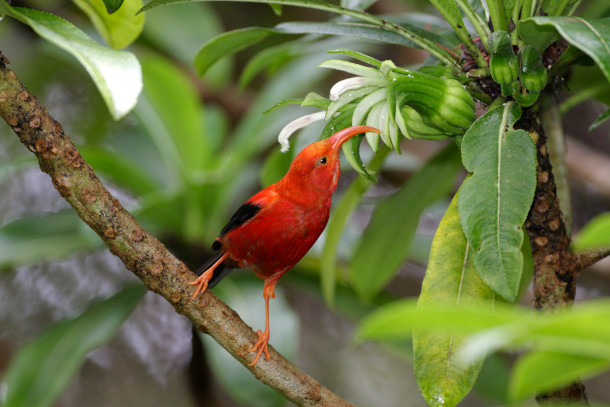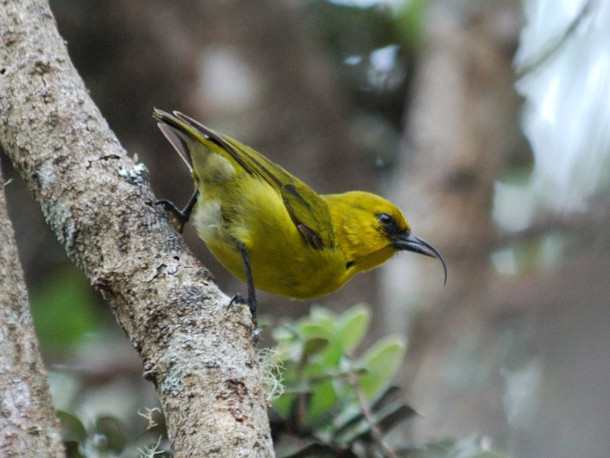BIRDNOTE®: Birds and Plants of Hawaii
Air Date: Week of September 8, 2023

The I’iwi or scarlet honeycreeper primarily lives in moist forests between 4,000 and 6,000 feet on the islands of Maui and Hawaii (commonly known as “the Big Island”) and uses its long, curved bill to drink nectar. (Photo: USFWS Pacific Region, public domain)
For millions of years the Hawaiian Islands have been forged with fiery lava, a destructive as well as life-bringing force. BirdNote®’s Michael Stein reports on how this rocky archipelago became so abundant in life.
Transcript
[BIRDNOTE THEME]
BELTRAN: For millions of years the Hawaiian Islands have been forged with fiery lava, a destructive as well as life-bringing force. BirdNote®’s Michel Stein reports on how this rocky archipelago became so abundant in life.
BirdNote®
The Birds and Plants of Hawaii
[A volcano erupting]
Massive volcanic eruptions brought forth the Hawaiian Islands from deep beneath the sea. [A volcano erupting]
How did these remote islands of lava rock grow lushly green with plant life?
[Waves] Birds played a vital role. Birds like the Pacific Golden-Plover we’re hearing now. [Pacific Golden-Plover calls]
Three-quarters of Hawaii’s native flowering plants probably came from seeds that hitched rides with birds. [Pacific Golden-Plover calls]
Plant seeds travel with birds in several ways. Sticky or barbed seeds adhere to the feathers — much like the seeds stuck in your socks after a walk in a weedy field. Other seeds travel in mud caked on a bird’s feet. And still others cross the ocean in the stomachs of birds. [Pacific Golden-Plover calls]

The ʻakiapōlāʻau is an endangered species of Hawaiian honeycreeper endemic to the island of Hawaii that eats insects in the bark of trees, like a woodpecker. (Photo: © Brooks Rownd)
The bird-borne seeds that sprouted in Hawaii evolved into more than a thousand new species. The most likely seed-carriers were strong fliers like plovers or tropicbirds, which travel thousands of miles across the Pacific. [Red-tailed Tropicbird sounds] Or perhaps the seeds hitched a ride on the ancestors of this Akiapola’au we’re hearing — caught in a storm and blown to the Hawaiian Islands. [Akiapola’au calls]
Learn more at BirdNote.org.
###
Bird audio provided by The Macaulay Library at the Cornell Lab of Ornithology, Ithaca, New York. Pacific Golden-Plover recorded by W. Ward. Red-tailed Tropicbirds recorded by C. Robbins.
Akiapola’au calls from honeycreeper-01
Assorted ambient recordings by Kessler Productions.
BirdNote’s theme music was composed and played by Nancy Rumbel and John Kessler.
Written by Bob Sundstrom
Producer: John Kessler
Executive Producer: Chris Peterson
© 2015 Tune In to Nature.org November 2013/2017/2019 Narrator: Michael Stein
ID# 111307plants2HIKPLU SotB-hawaii-04-2011-11-20
https://www.birdnote.org/listen/shows/birds-and-plants-hawaii
BELTRAN: For pictures, soar on over to the Living on Earth website, loe.org.
Links
Learn more on the BirdNote® website
Living on Earth wants to hear from you!
Living on Earth
62 Calef Highway, Suite 212
Lee, NH 03861
Telephone: 617-287-4121
E-mail: comments@loe.org
Newsletter [Click here]
Donate to Living on Earth!
Living on Earth is an independent media program and relies entirely on contributions from listeners and institutions supporting public service. Please donate now to preserve an independent environmental voice.
NewsletterLiving on Earth offers a weekly delivery of the show's rundown to your mailbox. Sign up for our newsletter today!
 Sailors For The Sea: Be the change you want to sea.
Sailors For The Sea: Be the change you want to sea.
 The Grantham Foundation for the Protection of the Environment: Committed to protecting and improving the health of the global environment.
The Grantham Foundation for the Protection of the Environment: Committed to protecting and improving the health of the global environment.
 Contribute to Living on Earth and receive, as our gift to you, an archival print of one of Mark Seth Lender's extraordinary wildlife photographs. Follow the link to see Mark's current collection of photographs.
Contribute to Living on Earth and receive, as our gift to you, an archival print of one of Mark Seth Lender's extraordinary wildlife photographs. Follow the link to see Mark's current collection of photographs.
 Buy a signed copy of Mark Seth Lender's book Smeagull the Seagull & support Living on Earth
Buy a signed copy of Mark Seth Lender's book Smeagull the Seagull & support Living on Earth

